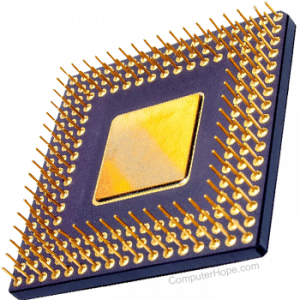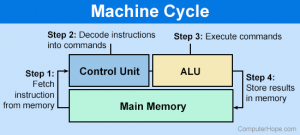The objectives of this assignment are first, to appreciate the importance and role of definition in technical writing, to understand how audience and purpose indicate the need for definition, to differentiate between the levels of details in definition, and finally, to select the right level of detail according to the situation.
Students will choose a relatively complex term used in their discipline or profession and introduce and explain the term to “non-technical readers.”
Term:
CPU(Central Processing Unit)
Reading Situation:
A professor in the Introduction to Computer Systems course explains the term CPU to students who have no prior knowledge of computer science.
Parenthetical Definition:
CPU is an acronym that stands for “Central Processing Unit”, which is the main processing chip that acts as the “brain” of a computer.
Sentence Definition:
The CPU is an integrated circuit chip of all kinds of computing devices that processes instructions comprising a program.
Expanded definition:
1.What is a CPU?

figure1.1 Illustration of a CPU
source: https://www.computerhope.com/jargon/c/cpu.htm
The CPU is responsible for carrying out all tasks in a computer. The CPU runs the operating system and applications, constantly receiving input from the user or active software programs. It processes the data and produces output, which may stored by an application or displayed on the screen (Christensson, 2014).
2.History of a CPU
2-1. First Generation (1940 – 1955)
Vacuum Tubes are the first generation of CPUs. It used very big size Vacuum Tubes and Magnetic Drums for memory. They were very expensive. The computer could solve one problem at the same time. Computers used the punched cards or paper tape for input/output devices.
2-2. Second Generation (1959 – 1965)
The second generation of CPUs used transistors that made the computers become cheaper, smaller, and faster. However, it still had the same problem with the vacuum tube, the heat generation, which caused the computer malfunctions. It still used the punched cards for input/output.
2-3. Third Generation (1965 – 1971)
The third generation was the first use of integrated circuits, which could run more than one program at once times. It did not use the punched card for input/output. It had a central program that monitored the memory.
2-4. Fourth Generation (1971 – 1980)
The fourth generation of CPUs used microprocessors that had thousands of integrated circuits in a single chip. In 1971, the first modern CPU, the Intel 4004, was invented and developed at Intel with the help of Ted Hoff. Since then, computers became more powerful and cheaper.
2-5. Fifth Generation (1980 – Present)
In the fifth generation, the production of microprocessor chips has ten million electronic components with the availability of very powerful and compact computers at cheaper rates. This generation is based on parallel processing hardware and Artificial Intelligence software.
3.How does a CPU work?
A computer unit is made up conceptually of three major components, ALU(the arithmetic/logic unit), CU(the control unit), and Registers(Memory Unit). The ALU and CU together are known as the CPU.

figure1.2 Major Component of Computer
source: https://www.computerhope.com/jargon/c/cpu.htm
3-1. ALU (The Arithmetic/Logic Unit)
The ALU performs mathematical, logical, and decision operations. It is where the data is held temporarily and where calculations take place. Arithmetic instructions include addition, subtraction, and shifting operations, while logic instructions include boolean comparisons, such as AND, OR, XOR, and NOT operations.
3-2. CU (The Control Unit)
The CU controls the flow of data within the CPU. It directs and interprets the execution of instructions as well as determines the particular instruction to be executed by reading the contents of the instructions.
3-3. Registers (The Memory Unit)
The Registers are high-speed storage areas that ALU uses to store data during calculations. It holds a binary value temporarily for storage, manipulation, and/or for simple calculations (Irv, 2014).
3-4. Operation of a CPU
The fundamental operation of a CPU is to execute the sequence of stored instructions, and each cycle must be synchronized to work together smoothly. The cycle is called an instruction cycle, and the clock rate is one of the crucial factors to determine the performance or speed of a CPU.
- A simple Cycle of CPU
- FETCH: get the next instruction from memory
- DECODE: figure out what it does
- EXECUTE: do the operation
- go back to FETCH

figure 1.3 Path of data
source: https://www.meccanismocomplesso.org/en/processors-how-they-are-made-and-how-they-work/
4. Comparing CPUs
The instruction cycle or the clock speed of a CPU, generally given in gigahertz(GHz) is a rough indication of how many calculations a CPU can run each second. It is useful to compare the performance between CPUs in the same family. For example, a CPU running at 50MHz will be about twice as fast as one with the same CPU running at 25MHz.
Works Cited:
Christensson, P. (2011, March 24). ALU Definition. Retrieved 2021, Jun 2, from https://techterms.com
Christensson, P. (2014, July 11). CPU Definition. Retrieved 2021, Jun 2, from https://techterms.com
Computer Hope. (2021). CPU. Retrieved 2021, Jun 2, from https://www.computerhope.com/jargon/c/cpu.htm
David, B. (2020). The central processing unit (CPU): Its components and functionality. Retrieved 2021, Jun 2, from https://www.redhat.com/sysadmin/cpu-components-functionality
Irv, E. (2014). The architecture of computer hardware, systems software, and networking: An information technology approach, 5th edition. Ringgold, Inc.
The History Of Central Processing Unit Information Technology Essay. Retrieved 2021, Jun 6, from https://www.uniassignment.com/essay-samples/information-technology/the-history-of-central-processing-unit-information-technology-essay.php